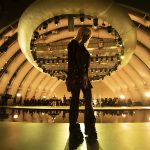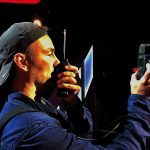Production Support Group and Collaborators Weigh In on Sport Fishing’s Biggest Event of the Year
Earn a living bass fishing? Fishing for a living? What may sound like utopia or exists only in someone’s dreams is a reality for the anglers who vie each year in the largest freshwater fishing tournament in the world. Geico Bassmaster Classic Presented by Dick’s Sporting Goods is the Super Bowl of fishing tournaments, held annually at a different lake/river and venue.
This year, for two days (March 16-17), a field of the top 52 bass anglers worked the waters at Lake Hartwell, on the Georgia/South Carolina border. On Day Three (March 18), the competitive field narrowed to the top 25 contenders, then just six, who brought their live catch to Bon Secours Wellness Arena in Greenville, SC for the final weigh-in. The first-place prize: $300,000. The total prize payout for the Classic is more than $1 million.
With a streaming webcast that had over 800,000 views last year, and close to 40,000 ticket holders filling the arena over the course of the weekend, the B.A.S.S. organization (Bass Anglers Sportsman Society) can clearly see the benefits of their decision to enhance the fan experience over the years. This year, Jason Aldean performed the opening night of the tournament.
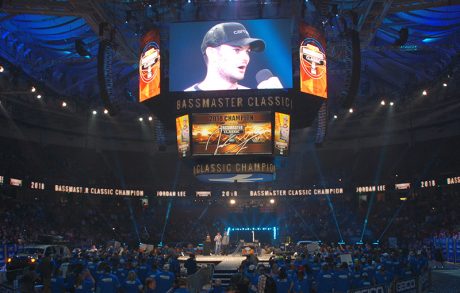
Hometown Hero
Larry Schmidt is the show producer for the production side of the event and also heads the design team for the staging. He owns Production Support Group, Inc. (PSG), which has been honored with Hometown Hero awards and nominations from both PLSN, for their lighting prowess, and FRONT of HOUSE, for sound. Schmidt, a veteran of the corporate theater world, has worked with Scott Whitfield, VP of Next Page Event Services, for more than a decade. Whitfield designed and provided rigging for the show and hired longtime associate Dave Ward as lighting designer. These three made up the design team.
Unlike any corporate theater or rock show, the participants and B.A.S.S. organizers are not from the entertainment field. Instead, their lifelong focus is squarely on fishing, as one proud winner was happy to state. Along with his role as producer, Schmidt has worked to educate others about the event, and how it has evolved over the years since it launched in 1971 and morphed from a fall to a summer to a late winter event.
“Historically,” says Schmidt, “we built sets to mimic the outdoor fishing scenes and video was mainly used for camera I-Mag. I proposed to the B.A.S.S. board that to stay relevant we need to move to another level of presentation; more akin to what the American public sees every day now. The 15-year-old viewer is going to have three minutes of attention span, so we better grab him. Otherwise, he’ll be saying, ‘Dad, can we go?’ Now, his father has to be interested too, so we need to give him the feeling like he’s at a music awards show.”
Schmidt looks at the arena full of fans and the production setting in it as an environment. “We introduced video panels, a lot of trussing, lights. They immediately grasped the truss concert look, for lack of a better term, but it took a bit to get them to understand video as a set element. To them, it’s playback. To me, it’s playback right now, but video plays a dual role, and I intended to explore that with this production.”
He points out that, due to increased scope of production, “the participating anglers are way more pumped up in this environment as well as the fans in the audience.”
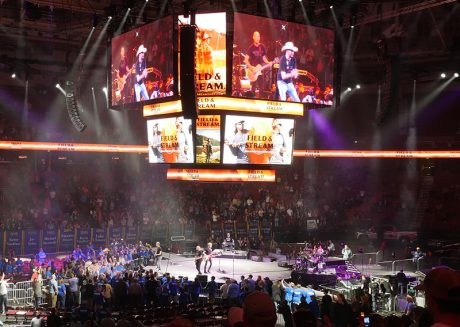
Lighting and Video Blend
LD Dave Ward had been thinking of creating a design for doing the Bassmaster show in the round for quite some time. With a massive scoreboard already in place at Bon Secours Arena, it was the ideal time to present his rendering to Schmidt and Whitfield when they got together for their annual creative meeting session. To their surprise, it closely resembled Schmidt’s “napkin” drawing.
“We all wanted a really clean stage this year, so I started with the scoreboard that already exists, and we built from there,” says Ward.
The rig within the venue, which ranges in capacity from about 16,000 to 19,000, depending on the event, has 90 points, 20 of which are dedicated to a grid that holds up the video center cluster of eight screens, supplied by Upstage Video. Inside those trusses, there were 32 inverted motors for independent movement of this surround of screens.
Greg Brown, project manager with Upstage Video, and his team handled all LED video support as well as the disguise media servers used for the Classic. They played a key role, helping with signal distribution between the JM Productions TV production truck and the live production support side.
Upstage Video also deployed 448 ROE MC7 tiles to create the halo of eight screens. The truck handled I-Mag and content. “The cueing for this show was not stacked,” says Brown. “Everything was a quick fire. With the grandMA, that was very easy to do.”
Ward needed a “bulletproof” light that would provide a good stage wash and deliver the right color temperature for camera. He spec’d the Vari-Lite VLX. Our vendor came back with, ‘Can you do it with 24 2K Fresnel’s?’ I realize people need to make money, and I would be able to make that work, as long as I had my 16 VLX. Between the 2K Fresnels and VLX, I got a good stage wash, but I could still utilize the VLX for other uses.”
These included diverting four each to the runways SR and SL as the anglers got out of their boats to get to center stage. “I don’t use spots for that entrance, because I don’t want spectacular action, just cool pools of light as they stride to the weigh in,” said Ward.
This is a signature use of lumens by Ward that sets the look of his designs apart from standard looks typically used. The “money” is well-lit all right, but Ward accentuates the intensity to fit the mood, which actually makes the subject stand out more than a blaze of white light.
“These guys make a good living from fishing, but they certainly don’t need to stand out like a lead singer at a rock show,” says Ward. The anglers have to qualify by competing and winning multiple tournaments leading up to get to the Classic. Besides prize earnings, sponsorship includes everything from bass fishing boats down to the lures the competitor’s use, which is why every angler has an outfit festooned with sponsors. NASCAR has nothing on these guys when it comes to sponsorship advertising.
A particular challenge on this event is getting adequate face light for camera, as practically everyone is wearing a baseball cap of some sort. This year, Ward used Elation’s TVL Cyc Light to solve that problem. He set these on concealed cases around the edge of the stage, to throw light up from the floor.
For the entrance way of the six finalists, a conglomeration of chaos made up of “just as many DJ-type lights he could place in the vom, to produce all flash and trash,” as Ward puts it. Spots are used for champions as well.
Pyro has its place, too, in the event for the money shot dubbed “The Hoist.” As the best angler raises his trophy at the end of the night, four liquid cryo jets mounted under the stage shoot columns of liquid white “smoke” 25 feet in the air, while two Venturi-type air blowers rain confetti over the stage.
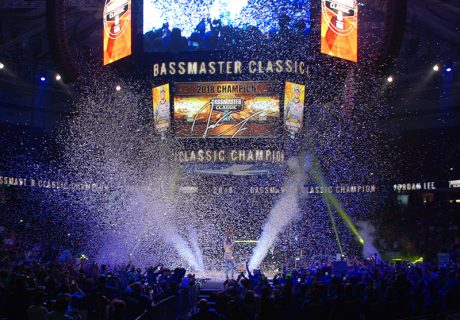
The Crew
The event occupies a unique place in the entertainment world — not quite corporate theater, and yet way more than a sporting event. LD Dave Ward assembled a versatile lighting crew for the Bassmaster Classic.
For the 2018 event, Steve Fryar served as the associate lighting LD. He directed the morning live webcast interview booth and calls followspots for the stage events. The booth, positioned on the upper level above the truck, and the bass boat entrance, both allowed for the perfect camera angles to capture the ambience of the crowd in the arena behind the hosts.
Matt Vengilio programmed and operated the console for all audience lighting. Certain fixtures were patched to both boards, such as the moles, which Ward used in combination with his stage looks, while Vengilio made use of them for the audience. Vengilio, who ran an Avolites board for all entrances, audience looks and ballyhoos, says his looks were geared to feel somewhat like corporate walkup, while Ward handled the stage and the more “rock ‘n’ roll” style looks on an Avo Pearl.
“We ran 12 universes streaming ACN signal out to Art-Net nodes,” says Vengilio. “Dave’s Avo was linked to mine. Based on priorities, we were able to treat it like an A/B switch. When Keith Hoagland, the talent LD for Aldean came in, we put his grandMA DMX info down through the same pipeline.”
“I had never married two different consoles down the same network before,” says Vengilio. “It was an interesting attempt, and it worked seamlessly. I did have the chance to discuss with Brad White of Avolites what I was getting into. He was a great help, and he assured me it would work. Just by setting different priority levels on each desk, the MA and the two Avo’s, I was able to give Hoagland control or take it back by activating two buttons on my Avo desk.”
The reason Ward breaks down control of his lighting rig to three operators is so each can respond to spontaneity of the event. Though the show is scripted, changes constantly take place. The ease of use with the Avo consoles made it a cinch.
Chad DeFranco served as ME, handling power for lights and sound. The son of well-known jazz clarinet player Buddy DeFranco, Chad grew up on the road with his father and mother, and the senior DeFranco encouraged the boy to learn how to manage the FOH position as an audio engineer. By age 15, he was mixing sound for his father full-time. In the ensuing years, Chad branched out into lighting and video as well. As Dave Ward put it, “he is the best ME I have ever worked with,” noting that another key team member is tech Matt “L-Do” Crowell.
Once all the lighting was balanced out the first day, the folks in the broadcast truck just captured the action rather than lending any direction to the designer.
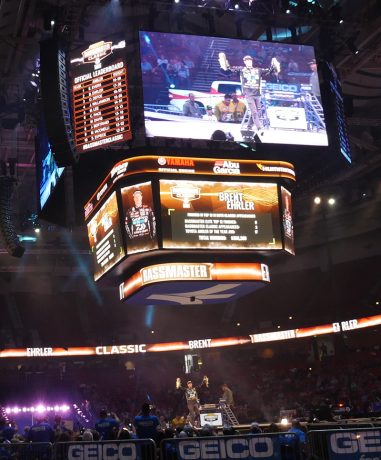
Current and Future Fans
For the 2018 Classic, Eric Lopez served as director of events for B.A.S.S. From an operations standpoint, he also oversaw the separate trade show associated with the fishing tournament, which was held at another site, along with the all-important “weigh-in” setup. As such, he and his team were in charge of hiring the production company to stage the event.
“We’ve been working with Larry and PSG over six years now,” Lopez says. “We used to build very theatrical stages that fit our fishing scene; like a pier with a lot of wood grains and nautical rope. But we really wanted to transition into video.
“We have fans that are purists, and we have young fans, so the challenge was to balance that,” Lopez adds. “We use a lot of imagery of the older legends of the sport, but we are doing so on some of the most advanced technology.
“The new look appeals to people who are exposed to other forms of entertainment like going to concerts and big huge stage shows,” Lopez continues. “We felt Larry’s team could help us advance that. Our sponsors love it as well, because we have the ability to make the entire house, the stage, the lights, and the ribbon combined to look like their brand.”
The Classic may be the most elaborate event on the B.A.S.S. calendar, but they hold many other tournaments and fishing-related events each year, in both rural and urban settings, Lopez notes. “We stage the events around the country, but we return to cities, so we always strive to keep it fresh, which is where the video really serves us.”
And while bass fishing might have once seemed unlikely to emerge into a spectator sport, that’s what’s happened, and the production team for the Bassmaster Classic have drawn upon other sporting spectacles for inspiration. Which makes total sense, when you think about it. “We look to what other sports are doing, because our fans watch other sports as well,” says Lopez. “It’s not just about the fishing; it’s about all the other entertainment components as well.”
